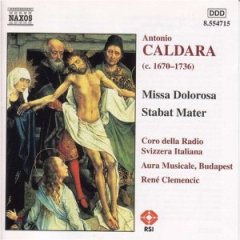Antonio Caldara - Missa Dolorosa - Stabat Mater - Sinfonias in G and E minor (1997)
Antonio Caldara - Missa Dolorosa - Stabat Mater - Sinfonias in G and E minor (1997)

Sant' Elena al Calvario: Introduzione, "Sinfonia No. 6 in G minor"
1. Sant' Elena al Calvario: Introduzione, "Sinfonia No. 6 in G minor" 04:49
Stabat mater
2. I. Stabat Mater dolorosa 01:39
3. II. Cujus animam gementem 01:53
4. III. Quis est home 04:37
5. IV. Sancta Mater 01:03
6. V. Tui nati vulnerati 01:49
7. VI. Fac me tecum 01:02
8. VII. Juxta crucem 01:06
9. VIII. Virgo virginum:01:28
10. IX. Fac, ut portem 02:32
11. X. Flammis ne urar succensus 00:00:58
12. XI. Christe, cum sit hinc exire 00:01:36
13. XII. Fac ut animae donatur 00:02:12
Gioseffo che interpreta i sogni: Introduzione, "Sinfonia No. 10 in E minor"
14. Gioseffo che interpreta i sogni: Introduzione, "Sinfonia No. 10 in E minor" 03:46
Missa dolorosa
15. I. Kyrie:06:54
16. II. Gloria 12:51
17. III. Credo 06:08
18. IV. Sanctus 01:07
19. V. Benedictus 01:54
20. VI. Agnus Dei 03:42
Swiss-Italian Radio Chorus
Aura Musicale Ensemble
Diego Fasolis – organ
Rene Clemencic – conductor
Until he arrived in Vienna in 1716, Venetian-born Antonio Caldara (1670-1736) was one of early 18th-century Italy’s most prominent opera composers and freelance cellists. However, his duties at the Viennese court required–in addition to opera–enormous amounts of church music, including cantatas, masses, oratorios, and various types of service music. During this last 20 years of his life Caldara obliged with hundreds of such pieces, including the mass and Stabat Mater on this program. It’s going too far to suggest a worthy comparison of Caldara’s Stabat Mater with Bach’s music, as the blurb on the disc’s back cover does, but this very substantial (nearly 25 minutes), Italianate (think Vivaldi and Corelli) work for soloists, chorus, and orchestra goes beyond mere function to display the effort of a fine melodist (yet nowhere near the caliber of Bach) as well as the telltale signs of complete mastery of form and forces. As you might expect from an opera composer, Caldara’s writing in both the mass and the Stabat Mater also shows an affinity for mood and effective text setting. A fondness for fugal-style writing and occasional harmonic surprises is apparent throughout. The chorus sings very well, and since we so rarely hear Italian choirs on recordings, it’s especially welcome to hear this very open, round, full-bodied ensemble sound. Similar compliments must go to the soloists, all of whom sing with an essential degree of emotional commitment that permeates their decidedly non-virtuosic music. The unnamed soloist in the Stabat Mater’s ninth verse, “Fac, ut portem” (the most beautiful of the work’s melodies) is a real pleasure to hear. Conductor René Clemencic, known to most listeners for his many flute recordings, directs a confident, very competent chamber orchestra that also plays alone in two of Caldara’s instrumental Sinfonias. The sound is close, vibrant, bottom-heavy and rumbly, this last especially noticeable at higher volume. ---David Vernier, classicstoday.com
download: uploaded anonfiles mega 4shared mixturecloud yandex mediafire solidfiles
Last Updated (Friday, 27 September 2013 22:23)
